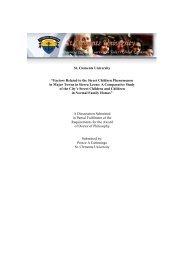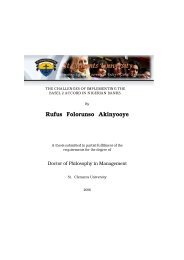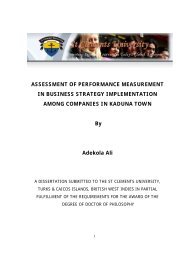The role of informal microfinance institutions in saving
The role of informal microfinance institutions in saving
The role of informal microfinance institutions in saving
You also want an ePaper? Increase the reach of your titles
YUMPU automatically turns print PDFs into web optimized ePapers that Google loves.
which is expressed as a percentage <strong>of</strong> the start<strong>in</strong>g <strong>of</strong> market value <strong>of</strong> an <strong>in</strong>vestment, while<br />
return on a portfolio (whereas a portfolio is def<strong>in</strong>ed as a comb<strong>in</strong>ation <strong>of</strong> two or more assets)<br />
is a weighted average <strong>of</strong> return on the particular assets mak<strong>in</strong>g up the portfolio.<br />
Where there is diversification <strong>of</strong> <strong>in</strong>vestment, it is called portfolio <strong>in</strong>vestment. Levy and Sarnat<br />
(1994) argue that when there is diversified <strong>in</strong>vestment, the <strong>in</strong>vestor reduces the risk while<br />
<strong>in</strong>creas<strong>in</strong>g the return on his <strong>in</strong>vestment. This makes the objective <strong>of</strong> diversified <strong>in</strong>vestment to<br />
maximize returns at a given level <strong>of</strong> risk.<br />
Risk (standard deviation) <strong>of</strong> the assets <strong>in</strong>volves events which may or may not occur, and is<br />
def<strong>in</strong>ed as the variation <strong>of</strong> returns from those expected, and its probability <strong>of</strong> occurrence can is<br />
calculated. When there is a spread <strong>of</strong> outcome, the stock is deemed as risky. <strong>The</strong> standard<br />
deviation is used to measure the risk <strong>of</strong> the <strong>in</strong>vested assets. When there is high standard<br />
deviation, the stock will be deemed as more risky, that the one with lower standard deviation.<br />
Investor considers both risk and returns when mak<strong>in</strong>g <strong>in</strong>vestment decisions, preferr<strong>in</strong>g higher<br />
returns and lower risk from his/her <strong>in</strong>vestment. This implies that if the <strong>in</strong>vestment has a higher<br />
rate <strong>of</strong> risky, it will be chose by the rational <strong>in</strong>vestor if its return is higher to <strong>of</strong>fset the risk<br />
should it occur.<br />
Brealey and Myers (2000) argue that <strong>in</strong>vestors may reduce the standard deviation <strong>of</strong> portfolio<br />
return if they choose stocks, which do not move together. This is from the idea that if assets<br />
are mov<strong>in</strong>g together, when they are comb<strong>in</strong>ed together, they will <strong>in</strong>crease the risk <strong>in</strong>stead <strong>of</strong><br />
reduc<strong>in</strong>g it. A common measure used to measure as whether the assets are mov<strong>in</strong>g together is<br />
correction coefficient. A positive correlation coefficient (usually taken as +1) shows that the<br />
comb<strong>in</strong>ed assets will not reduce the level <strong>of</strong> risk, while a negative correlation coefficient<br />
(usually taken as - 1) shows that the comb<strong>in</strong>ed assets will reduce the level <strong>of</strong> risk <strong>of</strong> portfolio.<br />
On the other hand, when correlation coefficient is zero, the risk <strong>of</strong> portfolio will equal the<br />
sum <strong>of</strong> variance <strong>of</strong> assets, while its return equals the <strong>in</strong>dividual assets returns.<br />
<strong>The</strong>re is also a view that <strong>in</strong>vest<strong>in</strong>g <strong>in</strong> a portfolio regardless their <strong>in</strong>dividual behavior will not<br />
reduce all risk when put together <strong>in</strong> a portfolio selection. <strong>The</strong>re are two types <strong>of</strong> risks<br />
associated with the stocks. <strong>The</strong>se are market risk and <strong>in</strong>dividual stock risk. A well diversified<br />
stock reduces stock risk, while not a market risk. This is because market (systematic) risk, apart<br />
98
















